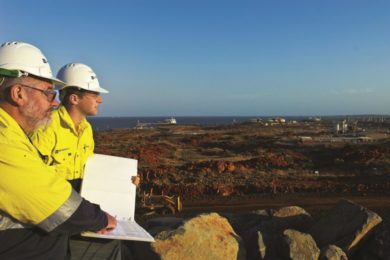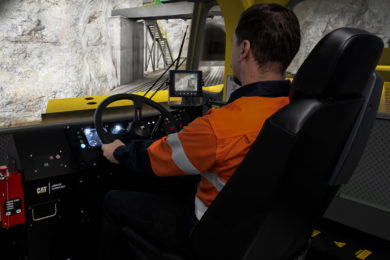 The initial Future Underground Materials Handling Study for Lundin Mining’s Neves-Corvo mining complex in southern Portugal identified and evaluated the underground materials handling and access options necessary to pursue the exploitation of the deeper Lombador copper/zinc resources as well as the Semblana copper deposit which are adjacent to the Neves-Corvo mine. The mine was examined in detail in IM January as part of the current Great Mines series on Lundin (Tenke Fungurume in March).
The initial Future Underground Materials Handling Study for Lundin Mining’s Neves-Corvo mining complex in southern Portugal identified and evaluated the underground materials handling and access options necessary to pursue the exploitation of the deeper Lombador copper/zinc resources as well as the Semblana copper deposit which are adjacent to the Neves-Corvo mine. The mine was examined in detail in IM January as part of the current Great Mines series on Lundin (Tenke Fungurume in March).
The Study indicated two preferred options:
• A new rock-hoisting and man-riding shaft approximately 1,200 m deep, located to the northeast of the existing mine surface facilities, situated between the Semblana and Lombador mineralization
• A new decline from the existing plant area equipped with a conveyor system and man and material access facilities. The Decline Option consists of a proposed two-leg decline driven by a high speed tunnel boring machine and would be aligned to pass close to and underneath the Semblana deposit and then on to deeper parts of the Lombador resource, reaching a similar ultimate depth as the Shaft Option.
The Shaft Option is expected to comprise conventional shaft systems with combination skip/cages providing a designed rock hoisting capacity of 5 Mt/y, coupled with rapid man-riding facilities to the lowest levels of the mine. The shaft would provide direct ventilation benefits and would allow ore and waste from production areas to be gravity-fed to a new deep haulage level. The shaft is expected to provide less positional and sequencing flexibility, as well as a longer development schedule, as compared to the Decline Option. Should the Shaft Option be selected, it could be in production approximately five years from project start. The Shaft Option is expected to have a higher capital cost and lower operating cost than the Decline Option.
The Decline Option is expected to comprise an approximately 6-m diameter, inclined tunnel equipped with a conveyor system for rock hoisting, with the same design capacity as the Shaft Option at 5 Mt/y. At a current design gradient of 1:5, the length of the decline from surface to the Semblana area is about 5,200 m. Access to the deeper parts of the Lombador mineralisation would require a decline extension of a further 2,200 m. Man access would be provided by a rope haulage system or conventional vehicles depending on the final selected gradient of the decline. The Decline Option is expected to allow earlier first production than the Shaft Option, with potential to be operational in some four years from project start. This option would also allow phased expenditure and sequential development of the Semblana and Lombador mineralisation. The Decline Option could also have the added benefit of providing greater flexibility in accessing several other areas of potential mineralization located near the Semblana deposit as identified by the recent high-grade copper intercepts from initial drilling on 3D seismic targets, as announced in the Company’s December 15, 2011 press release.
A next level of study is advancing with a high priority, taking into account ongoing new exploration results, and to further develop designs and comparisons between the two options. The results of the initial study are not intended to imply that either option has been determined to be economically viable. The Semblana mineral resource is still categorised as Inferred and comments on economic potential are not provided. Given the preliminary nature of the study and the number of assumptions necessary to be made at this stage, capital and operating cost estimates for the Shaft and Decline Options are still at a conceptual stage and are insufficient for public dissemination. Studies are advancing to refine comparisons between the two options with anticipated completion by Q2 2012, to select a single preferred option for subsequent feasibility level study.
A significant exploration drilling program is planned for 2012 which is expected to increase the current resource at Semblana. Expansion of this resource and drilling success from other nearby seismic reflector targets are likely needed to warrant a major underground infrastructure investment dedicated just to this area. Additional drilling is progressing near recently encountered high grade copper intercepts south and southwest of the existing Semblana resource.
In parallel to ongoing study work and to fast track the schedule for accessing the Semblana area, Lundin has commenced planning and budgeting for development of an access ramp to the Semblana deposit from the Zambujal orebody. Subject to investment approvals, the ramp development is targeted to commence prior to the end of Q2 2012 with the objective of accessing an intermediate level about 750 m below surface in two to three years, from which further exploration and infill drilling can be carried out. Subject to this drilling, further design and study results, this ramp will continue to approximately 950 m depth which is the conceptual design level of a main haulage way for Semblana. This access ramp from Zambujal would be used with either the Shaft or Decline Options.
As previously announced in the December 12, 2011 press release, the development of the Lombador deposit (Lombador Phase 1) is progressing to enable ramp up of zinc production to in excess of 60,000 t/y by 2014. The main access ramp for Lombador Phase 1 has now reached a level 850 m below surface and is at the elevation to start the exploration drive planned for detailed in-fill drilling of the deeper Lombador mineralisation.
Paul Conibear, CEO of Lundin Mining: “The successive stages of refinement of the materials handling study are essential for the future development of new resources at Neves-Corvo. We intend to move forward aggressively with investment plans at the mine. Ongoing exploration efforts on Semblana, Lombador, and the drilling success we have recently achieved on new targets will continue to shape and support our investment in future underground materials handling infrastructure at Neves-Corvo.”









